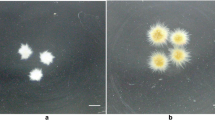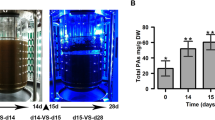Abstract
As one of the strategies for efficient production of a metabolite from cell cultures, a kinetic model is very useful tool to predict productivity under various culture conditions. In this study, we propose a kinetic model for flavonoid production in tea cell culture based on the cell life cycle and expression of PAL, the gene encoding phenylalanine ammonia-lyase (PAL)—the key enzyme in flavonoid biosynthesis. The flavonoid production rate was considered to be related to the amount of active PAL. Synthesis of PAL was modelled based on a general gene expression/translation mechanism, including the transcription of DNA encoding PAL into mRNA and the translation of PAL mRNA into the PAL protein. The transcription of DNA was assumed to be promoted at high light intensity and suppressed by a feedback regulatory mechanism at high flavonoid concentrations. In the model, mRNA and PAL were considered to self-decompose and to be lost by cell rupture. The model constants were estimated by fitting the experimental results obtained from tea cell cultures under various light intensities. The model accurately described the kinetic behaviors of dry and fresh cell concentrations, glucose concentration, cell viability, PAL specific activity, and flavonoid content under a wide range of light intensities. The model simulated flavonoid productivity per medium under various culture conditions. Therefore, this model will be useful to predict optimum culture conditions for maximum flavonoid productivity in cultured tea cells.





Similar content being viewed by others
Abbreviations
- DCW:
-
Dry cell weight
- FCW:
-
Fresh cell weight
- PAL:
-
Phenylalanine ammonia-lyase
- C Ed :
-
Specific activity of PAL per cell (kat/gDCW)
- C Md :
-
mRNA content per cell (/gDCW)
- C Pd :
-
Flavonoid content per cell (mg/gDCW)
- C Pd,max :
-
Maximum flavonoid content per cell (mg/gDCW)
- E :
-
Specific activity of PAL per medium (kat/dm3)
- I :
-
Light intensity (lux)
- k Ed :
-
Rate constant of PAL self-decomposition (/day)
- k Eg :
-
Rate constant of PAL translation (kat/day)
- k i :
-
Rate constant of cell rupture (/day)
- K l :
-
Light inhibition constant of vacuole formation (lux)
- k Md :
-
Rate constant of mRNA self-decomposition (/day)
- k Mg :
-
Rate constant of transcription (/gDCW/day)
- k Pg :
-
Rate constant of flavonoid production (mg/kat/day)
- k s :
-
Rate constant of cell lysis (/day)
- K vb :
-
Light inhibition constant of non-vacuole formation (lux)
- k w :
-
Water content of non-vacuole (–)
- L m :
-
Light saturation constant of transcription (lux)
- M :
-
mRNA amount per medium (/dm3)
- P :
-
Flavonoid amount per medium (mg/dm3)
- S :
-
Glucose concentration (g/dm3)
- t :
-
Culture period (day)
- X d :
-
Dry cell concentration (gDCW/dm3)
- X f :
-
Fresh cell concentration (gFCW/dm3)
- X l :
-
Vacuole concentration (g/dm3)
- X nb :
-
Non-viable non-vacuole concentration (g/dm3)
- X vb :
-
Viable non-vacuole concentration (g/dm3)
- V :
-
Cell viability (–)
- Y :
-
Yield of non-vacuole on substrate (–)
- Z :
-
Vacuole formation rate constant (/day)
- α :
-
Light promotion coefficient of transcription (–)
- μ :
-
Specific growth rate constant (dm3/g/day)
- χ :
-
Vacuole content (–)
References
Aquilano K, Baldelli S, Rotilio G, Ciriolo MR (2008) Role of nitric oxide synthases in Parkinson’s disease: a review on the antioxidant and anti-inflammatory activity of polyphenols. Neurochem Res 33:2416–2426
Steinmann J, Buer J, Pietschmann T, Steinmann E (2013) Anti-infective properties of epigallocatechin-3-gallate(EGCG), a component of green tea. Br J Pharmacol 168:1059–1073
Forrest GI (1969) Studies on the polyphenol metabolism of tissue cultures derived from the tea plant (Camellia sinensis L.). Biochem J 113:765–772
Zaprometov MN, Strekova VYu, Subbotina GA, Zagoskina NV (1986) Kinetin action on differentiation and phenolic compounds formation in tea callus culture. Sov Plant Physiol 33:282–289
Nikolaeva TN, Zagoskina NV, Zaprometov MN (2009) Production of phenolic compounds in callus cultures of tea plant under the effect of 2,4-D and NAA. Russ J Plant Physiol 56:45–49
Muthaiya MJ, PraveenNagella Thiruvengadam M, Mandal AA (2013) Enhancement of the productivity of tea (Camellia sinensis) secondary metabolites in cell suspension cultures using pathway inducers. J Crop Sci Biotechnol 16:143–149
Zaprometov MN, Zagoskina NV (1987) Further evidence for chloroplast participation biosynthesis of phenolic compounds. Sov Plant Physiol 34:136–143
Strekova VYu, Zagoskina NV, Subbotina GA, Zaprometov MN (1989) Effect of prolonged illumination on synthesis of phenolic compounds and chloroplast formation in tea callus tissues. Sov Plant Physiol 36:65–71
Zagoskina NV, Usik TU, Zaprometov MN (1990) Effect of illumination time on phenol metabolism of photomixotrophic tea callus cultures. Sov Plant Physiol 37:829–834
Cetin ES (2014) Induction of secondary metabolite production by UV-C radiation in Vitis vinifera L. Öküzgözü callus cultures. Biol Res 47:37
Shibasaki-Kitakawa N, Takeishi J, Yonemoto T (2003) Improvement of catechin productivity in suspension cultures of tea callus cells. Biotechnol Prog 19:655–658
Bulgakov VP, Tchernoded GK, Veselova MV, Fedoreyev SA, Muzarok TI, Zhuravlev YN (2011) Catechin production in cultured cells of Taxus cuspidata and Taxus baccata. Biotechnol Lett 33:1879–1883
Shibasaki N, Yonemoto T, Tadaki T (1993) Application of five-state structured models for growth and secondary metabolite production in cultures of Nicotiana tabacum. J Chem Tech Biotechnol 58:151–157
Shibasaki N, Obika R, Yonemoto T, Tadaki T (1995) Kinetic analysis for effect of initial substrate concentration on growth and secondary metabolite production in cultures of Nicotiana tabacum. J Chem Tech Biotechnol 63:201–208
Leudking R, Piret EL (1959) A kinetic study of the lactic acid fermentation. J Biochem Microbiol Technol Eng 1:393–412
Wang Y, Gao L, Shan Y, Liu Y, Tian Y, Xia T (2012) Influence of shade on flavonoid biosynthesis in tea (Camellia sinensis (L.) O. Kuntze). Sci Hortic 141:7–16
Howles PA, Sewalt V, Paiva NL, Elkind Y, Bate NJ, Lamb C, Dixon RA (1996) Overexpression of l-phenylalanine ammonia-lyase in transgenic tobacco plants reveals control points for flux into phenylpropanoid biosynthesis. Plant Physiol 112:1617–1624
Dixon RA, Achnine L, Kota P, Liu CJ, Reddy MSS, Wang LJ (2002) The phenylpropanoid pathway and plant defence—a genomics perspective. Mol Plant Pathol 3:371–390
Chang J, Luo J, He G (2009) Regulation of polyphenol accumulation by combined overexpression/silencing key enzymes of phyenylpropanoid pathway. Acta Biochim Biophys Sin 41:123–130
Shibasaki N, Hirose K, Yonemoto T, Tadaki T (1992) Suspension culture of Nicotiana tabacum cells in a rotary-drum bioreactor. J Chem Biotechnol 53:359–363
Dubois M, Gilles KA, Khamilton J, Rebers PA, Smith F (1956) Colorimetric method for determination of sugars and related substances. Anal Chem 28:350–356
Cheng GW, Breen PJ (1991) Activity of phenylalanine ammonia-lyase (PAL) and concentrations of anthocyanins and phenolics in developing strawberry fruit. J Am Soc Hortic Sci 116:865–869
Bate NJ, Orr J, Ni W, Meromi A, Nadler-Hassar T, Doerner PW, Dixon RA, Lamb CJ, Elkind Y (1994) Quantitative relationship between phenylalanine ammonia-lyase levels and phenylpropanoid accumulation in transgenic tobacco identifies a rate-determining step in natural product synthesis. Proc Natl Acad Sci USA 91:7608–7612
Logemann E, Tavernaro A, Schulz W, Somssich IE, Hahlbrock K (2000) UV light selectively coinduces supply pathways from primary metabolism and flavonoid secondary product formation in parsley. Proc Natl Acad Sci USA 97:1903–1907
Zhang X, Gou M, Liu C-J (2013) Arabidopsis Kelch Repear F-box proteins regulate phenylpropanoid biosynthesis via controlling the turnover of phenylalanine ammonia-lyase. Plant Cell 25:4994–5010
Zaprometov MN (1992) On the functional role of phenolic compounds in plants. Sov Plant Physiol 39:802–809
Chappell J, Hahlbrock K (1984) Transcription of plant defence genes in response to UV light or fungal elicitor. Nature 311:76–78
Takeda J, Abe S, Hirose Y, Ozeki Y (1993) Effect of light and 2,4-dichlorophenoxyaceti acid on the level of mRNAs for phenylalanine ammonia-lyase and chalcone synthase in carrot cells cultured in suspension. Physiol Plant 89:4–10
Hoffmann T, Schwab W, Hajirezaei M-R, Paul VS, Heller W, Schaffner AR (2012) Feedback inhibition of the general phenylpropanoid and flavonol biosynthetic pathways upon a compromised flavonol-3-O-glycosylation. J Exp Bot 16:1–14
Kurata H, Kaizuka Y, Seki M, Furusaki S (1999) Mathematical model analyzes light-controlled expression of the CHS promoter in BY-2 cells. Biochem Eng J 4:65–72
Muramatsu K (1991) Cha no Kagaku. Asakura Shoten, Tokyo, p 42
Nelder JA, Mead R (1964) A simplex method for function minimization. Comput J 7:308–313
Alberts B, Bray D, Lewis J, Raff M, Roberts K, Watson JD (1989) Molecular biology of the cell, 2nd edn. Gardland Publishing, New York, pp 1137–1186
Zagoskina NV, Fedoseeva VG, Frolova LV, Azarenkova ND, Zaprometov MN (1994) Tissue culture of tea plant: differentiation, ploidy level, and formation of phenolic compound. Russ J Plant Physiol 41:672–676
Glicklis R, Mills D, Sitton D, Stortelder W, Merchuk JC (1999) Polysaccharide production by plant cells in suspension: experiments and mathematical modeling. Biotechnol Bioeng 57:732–740
van Gulik WM, Ten Hoopen HJG, Heijnen JJ (1992) Kinetics and stoichiometry of growth of plant cell cultures of Catharanthus roseus and Nicotiana tabacum in batch and continuous fermentors. Biotechnol Bioeng 40:863–874
Betz B, Schafer E, Hahlbrock K (1978) Light-induced phenylalanine ammonia-lyase in cell-suspension cultures of petroselinum hortense. Arch Biochem Biophys 190:126–135
Author information
Authors and Affiliations
Corresponding author
Rights and permissions
About this article
Cite this article
Shibasaki-Kitakawa, N., Iizuka, Y., Takahashi, A. et al. A kinetic model for flavonoid production in tea cell culture. Bioprocess Biosyst Eng 40, 211–219 (2017). https://doi.org/10.1007/s00449-016-1688-4
Received:
Accepted:
Published:
Issue Date:
DOI: https://doi.org/10.1007/s00449-016-1688-4




